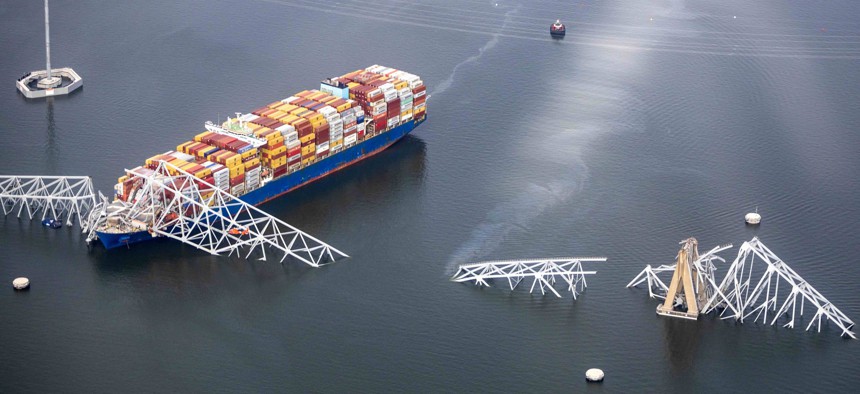Rebuilding the collapsed Baltimore bridge will be a ‘FAR bigger challenge’

In an aerial view, the cargo ship Dali is seen after running into and collapsing the Francis Scott Key Bridge in Baltimore, Maryland. Tasos Katopodis via Getty Images
While recent bridge replacements have been completed in a matter of weeks, this incident will be tougher to recover from and have wider impacts.
President Joe Biden promised Tuesday that the federal government would “move heaven and earth” to reopen the Port of Baltimore and rebuild the Francis Scott Key Bridge that collapsed earlier that morning. But the recovery promises to be far more challenging than those of other bridge collapses in recent years.
The steel trusses of the 47-year-old bridge came down in less than a minute early Tuesday morning after a container ship collided with a pier that supported the bridge. That debris is at the bottom of the Patapsco River, effectively blocking any other ships from crossing into the Baltimore Harbor.
That could have a major economic impact for the region, as Baltimore’s port is one of the nation’s busiest. It handles more roll-on, roll-off cargo like automobiles and construction equipment than any other port in the country. It is also a major distribution hub for Amazon and a major container port.
“Rerouting around the Port of Baltimore will have impacts on ports, railroads and trucking,” said John Porcari, a two-time Maryland transportation secretary who served as advisor to the Biden administration on clearing backlogs at several ports in the wake of the pandemic. “This incident will directly impact traffic, not just regionally in Baltimore, but throughout the Northeast seaboard, and goods movement throughout that same area. Since we have underinvested in our transportation system until very recently, we have little excess capacity or resiliency in our supply chain.”
Every import or export container, plus every piece of machinery that rolls on or off of ships, that is currently in the port will have to be sent by rail or truck to another destination, Porcari added.
The challenge of rebuilding the Baltimore bridge would be a “FAR bigger challenge” than in Philadelphia, where a section of Interstate 95 collapsed last June, Porcari said. It would even be more challenging than replacing a section of Interstate 5 that collapsed in Washington or the 2007 Minneapolis bridge collapse, he added.
Public officials, like many residents in the region, were in shock about the sudden disappearance of an iconic structure. Maryland Gov. Wes Moore flew back from Boston after hearing about the collapse. “This is not just unprecedented,” Moore told reporters. “It’s heartbreaking.”
The crew of the container ship, called the Dali, sent a mayday alert before the vessel crashed into the pier. They warned that the ship had lost steering. Local law enforcement shut down the bridge shortly before the collision, but a construction crew was still on it when the Dali struck. Emergency personnel continued to search the water for survivors Tuesday afternoon.
The closure of Interstate 695 over the bridge could lead to cascading traffic problems. The span handled approximately 30,000 vehicles a day, many of them trucks that could not use the tunnel under the harbor because they carry hazardous materials.
The diversion of trucks plus any extra vehicle traffic to move stranded cargo at the port could lead to big increases in noise and congestion for several Baltimore neighborhoods, said Celeste Chavis, a professor and chair of the transportation and urban infrastructure studies at Morgan State University in Baltimore.
City officials should ensure that there are “no long-term impacts from an employment standpoint” from the incident, said Chavis, who served as a co-chair of Baltimore Mayor Brandon Scott’s transportation and infrastructure transition committee. She’s concerned that any makeshift diversions implemented could become permanent, which could threaten jobs at Amazon and at the port for city residents.
Biden said he would visit Baltimore “as soon as I can.” The president also said he wanted the federal government to pay for replacing the bridge.
“We’re going to work with our partners in Congress to make sure the state gets the support it needs,” he said. “It’s my intention that the federal government will pay for the entire cost of reconstructing that bridge, and I expect the Congress to support my effort.”
Public officials haven’t discussed rebuilding plans yet. But Mehdi Shokouhian, a civil engineering professor at Morgan State, said it’s possible that engineers could use the piers from the bridge that were not hit as part of the structure for a replacement span. But he stressed that the design of the bridge did not appear to be the reason for the bridge collapse.
“Even if this bridge was a newly constructed one, something would have happened when [the ship] hit the bridge,” Shokouhian said, “because the magnitude of the force that this bridge was hit by was huge.”
Daniel C. Vock is a senior reporter for Route Fifty based in Washington, D.C.
NEXT STORY: Florida is about to erase climate change from most of its laws






